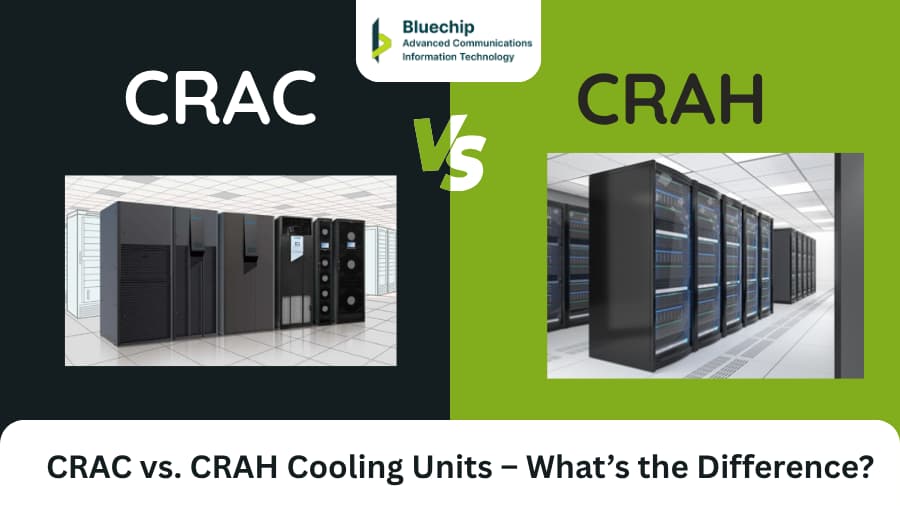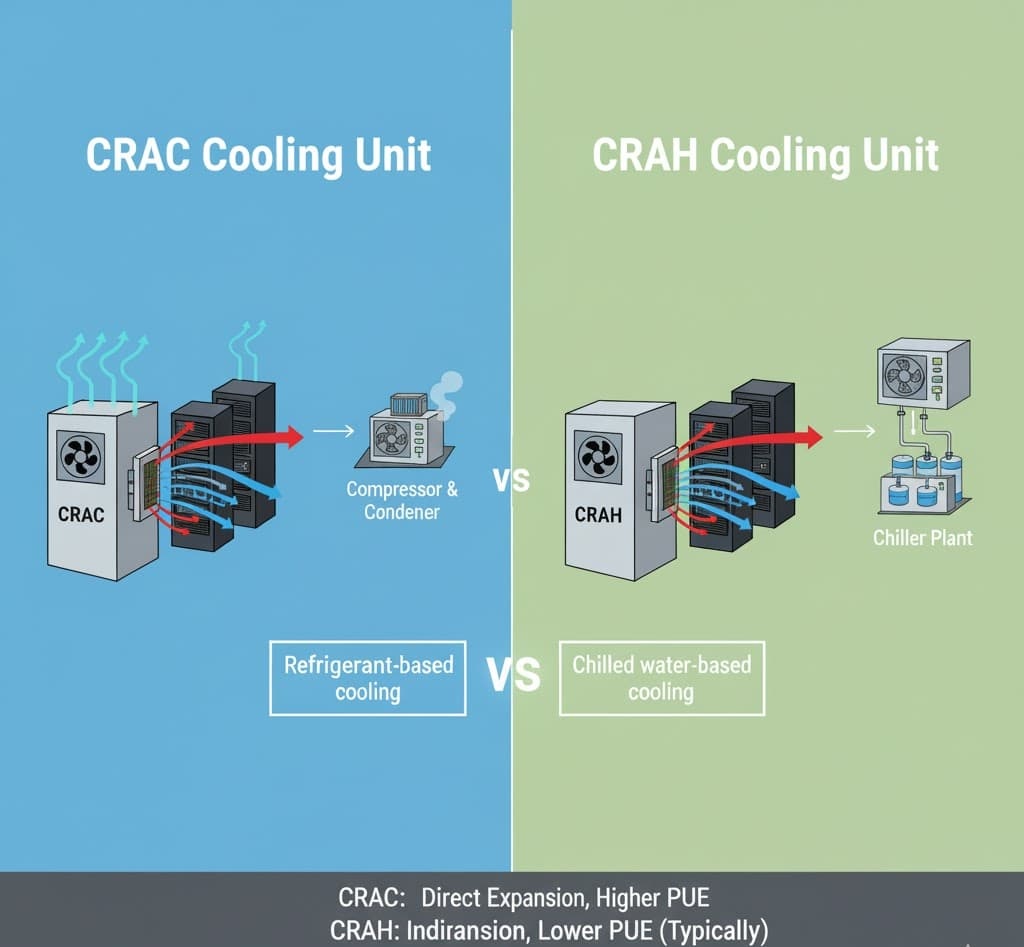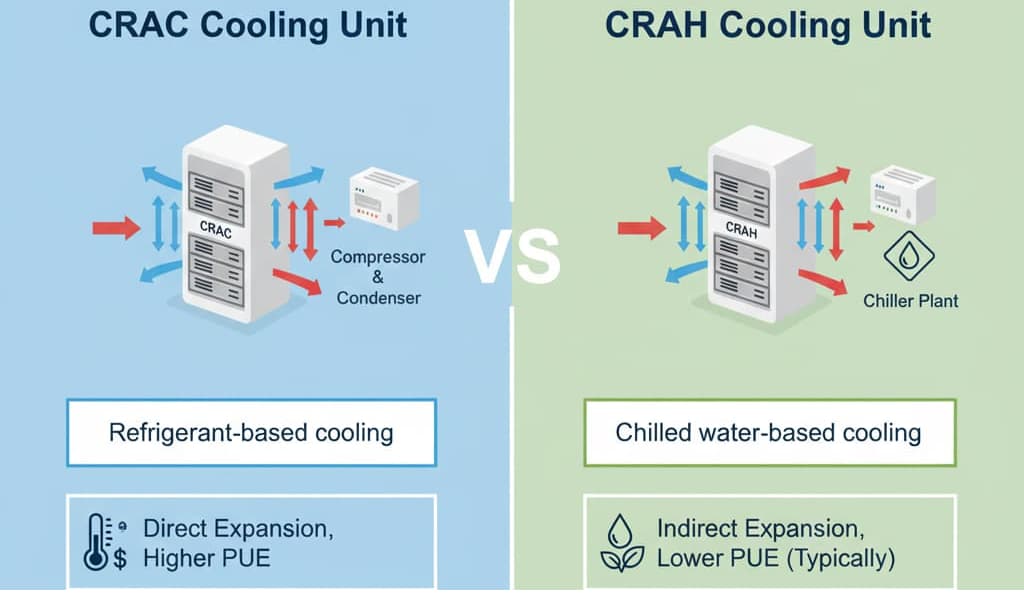
CRAC vs. CRAH Cooling Units – What’s the Difference?
Maintaining the machines’ cooling is not only a cost of operation in data centers; it is vital to their survival. Servers produce enormous amounts of heat, and excessive heat can cause equipment failure, performance issues, and data loss. For this reason, specialized cooling is essential to any successful Data Center Solutions in Saudi Arabia.
CRAC and CRAH are two acronyms that are frequently used when talking about cooling equipment. They work in fundamentally different ways, despite having similar sounds and doing similar tasks. Designing a data center that is dependable and energy-efficient requires an understanding of this distinction.
Let’s examine the world of computer room air conditioners (CRAC) and computer room air handlers (CRAH).

CRAC Units – The Traditional All-in-One Cooler
Computer Room Air Conditioner is referred to as CRAC. Consider a CRAC unit as your home’s enormous, high-tech air conditioner. It manages the cooling process from beginning to end on its own.
How a CRAC Unit Works (The Simple Science)
The refrigeration cycle, which a CRAC unit uses, consists of four primary parts –
1. Evaporator – The server room’s hot air is drawn in through the evaporator. A liquid refrigerant, such as Freon, absorbs the heat inside and transforms into a gas.
2. Compressor – By compressing the refrigerant gas, this device significantly raises its pressure and temperature. The component that consumes the most electricity is this one.
3. Condenser – Heat is released from the condenser. Similar to the large fan unit outside your home air conditioner, the condenser of smaller CRAC units is frequently located outside the building. After releasing its heat into the surrounding air, the heated gas transforms back into a liquid.
4. Expansion Valve – To restart the cycle, the expansion valve regulates the flow of liquid refrigerant back to the evaporator.
Key Features and Functions
- Dehumidification – A CRAC unit can regulate humidity and temperature because it employs a direct refrigeration cycle. Controlling humidity is essential in locations like Data Centers in Saudi Arabia, where temperature fluctuations can be severe, to avoid condensation and static electricity, two things that can damage electronics.
- Simplicity – The system is all-in-one. Installing a CRAC unit and connecting it to power and an outdoor condenser is how you get cooling.
The Big Trade-off – Energy Use
Electricity powers the compressor, a mechanical powerhouse. Because of this, CRAC units are easy to install but frequently use less energy than their CRAH counterparts, particularly in large-scale operations.
CRAH Units – The Smart, Separate Handler
The acronym for Computer Room Air Handler is CRAH. A CRAH unit lacks a compressor and a refrigeration cycle, in contrast to a CRAC unit. All it is is a heat exchanger.
How a CRAH Unit Works (The Heat Exchange)
Separating the cooling generation from the air handling is how a CRAH unit operates –
- It uses the servers’ hot air.
- A chilled water coil is used. Hot air from a central cooling source flows over a coil inside the CRAH unit that is filled with cold water (or another liquid coolant, such as glycol).
- Heat is transferred. The chilled water warms a little as the heat from the air enters it. The server room receives a blast of the now-cooled air.
- The hard work is done by the Chiller. After that, the heated water is pumped back to a central facility known as a chiller. The actual refrigeration cycle is carried out by the chiller, which is typically found outside or in a special utility room, to cool the water once more.
Key Features and Flexibility
1. Energy Efficiency – The compressor inside a CRAC unit uses a lot of power, but the CRAH unit only uses fans to move air and pumps to move water. In order to lower the operating expenses of big data center solutions in Saudi Arabia, this separation is essential.
2. Scalability – It is much simpler to increase capacity by adding more water chillers without having to replace every server room unit because the cooling is centralized at the Chiller plant.
3. Free Cooling Potential – The greatest benefit is the potential for free cooling! The CRAH system can cool the water using only outside air when the outside air is sufficiently cool, such as on some winter nights, and the chiller can be completely turned off. This offers significant energy savings and is referred to as “Free Cooling.”
The Trade-off – Complexity
The CRAH system is a component of a more extensive and intricate infrastructure that consists of reservoirs, pipes, water pumps, and chillers. The entire water loop needs more planning and upkeep.
CRAC vs. CRAH – The Head-to-Head Comparison

Their cooling method is the primary distinction. Like a typical home air conditioner, a CRAC unit is an all-in-one system that operates on the Direct Expansion (DX) refrigeration cycle. The entire cooling and dehumidification process is carried out by its internal parts, which include the compressor, condenser, and evaporator.
The CRAC is a self-contained solution because the compressor, the central component of the refrigeration system, is either inside the unit or close by. A CRAH unit, on the other hand, is just an air handler. The compressor and condenser are absent. The air is cooled by a chilled water coil. Its main internal parts are the strong fans and water coil, and it gets all of its cold water from a separate, centralized chiller system.
Impact on Energy Use and Efficiency
This mechanical difference directly impacts Energy Use. In comparison to a CRAH system, the CRAC unit’s internal compressor is a mechanical workhorse that uses a lot of electricity, resulting in a generally higher Power Usage Effectiveness (PUE). Due to this, CRAC units are less effective in large-scale deployments. However, a CRAH unit uses less energy to operate because it only uses power for its fans and water pumps.
For large-scale data center solutions in Saudi Arabia, where reducing energy footprints is crucial, CRAH systems also enable data centers to employ “free cooling” techniques, which use cold outside air or water to assist the chiller. This makes data centers much more cost-effective and energy-efficient.
Control and Application Suitability
Since water condensation is a byproduct of the CRAC unit’s direct refrigeration cycle, it naturally excels at humidity control when it comes to air quality. Although the CRAH unit is excellent at controlling temperature, it has limited natural humidity control and frequently needs an extra, costly reheat coil to dry the air, which adds complexity. As a result, the project’s size and scope determine the unit selection.
Smaller server rooms, telecom closets, and remote edge facilities without the substantial water piping infrastructure required for a central chiller plant are the best candidates for CRAC units. In contrast, large data centers, hyperscale facilities, and operations that prioritize long-term energy efficiency, a key focus for comprehensive data center services in Saudi Arabia, are best suited for CRAH units.
The Best Choice for Data Centers in Saudi Arabia

The size and location of the facility typically determine which of the CRAC and CRAH is best for Data Center Services in Saudi Arabia providers.
1. For Hyperscale Data Centers – CRAH units are nearly always preferred by large facilities in the Middle East. Simply put, the energy savings from separating the refrigeration cycle are too great to be disregarded. Given the high demand for cooling in the desert climate, the initial cost and complexity are outweighed by significant long-term electricity savings.
2. For Edge Computing/Smaller Sites – CRAC units continue to be the sensible option for standalone, smaller sites, such as distant “edge” data centers or telecom rooms. They don’t require a specialized central water plant and require a simpler initial setup.
In order to lower operating costs and the environmental impact of data center solutions in Saudi Arabia, the trend is strongly leaning toward highly efficient CRAH systems combined with cutting-edge Free Cooling techniques. This trend makes the most of any cool air that is available, even on winter nights.
Both CRAC and CRAH are ultimately crucial components of the cooling puzzle. Your scale, budget, and long-term efficiency objectives will all influence which one is best for you.









